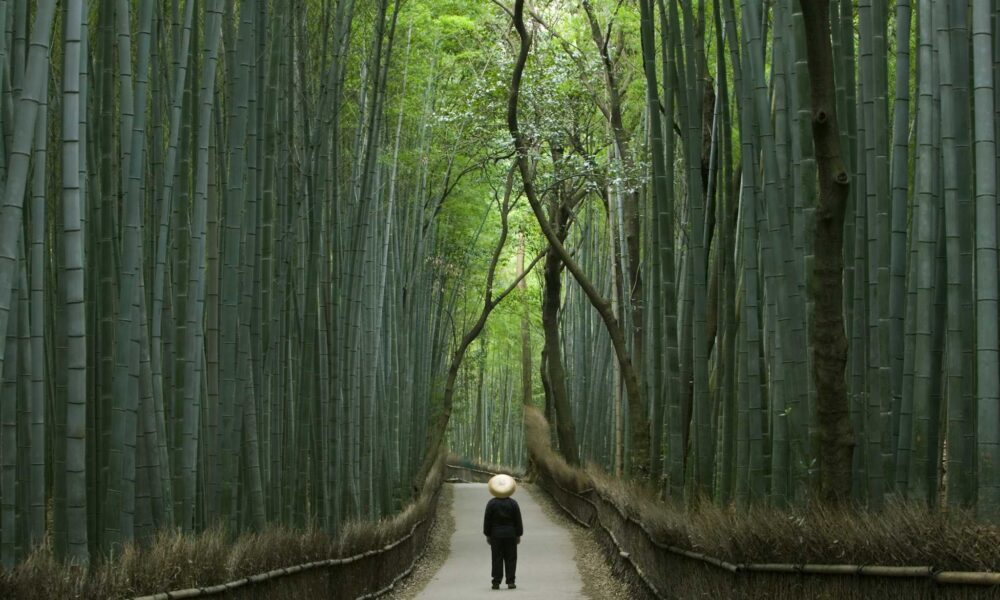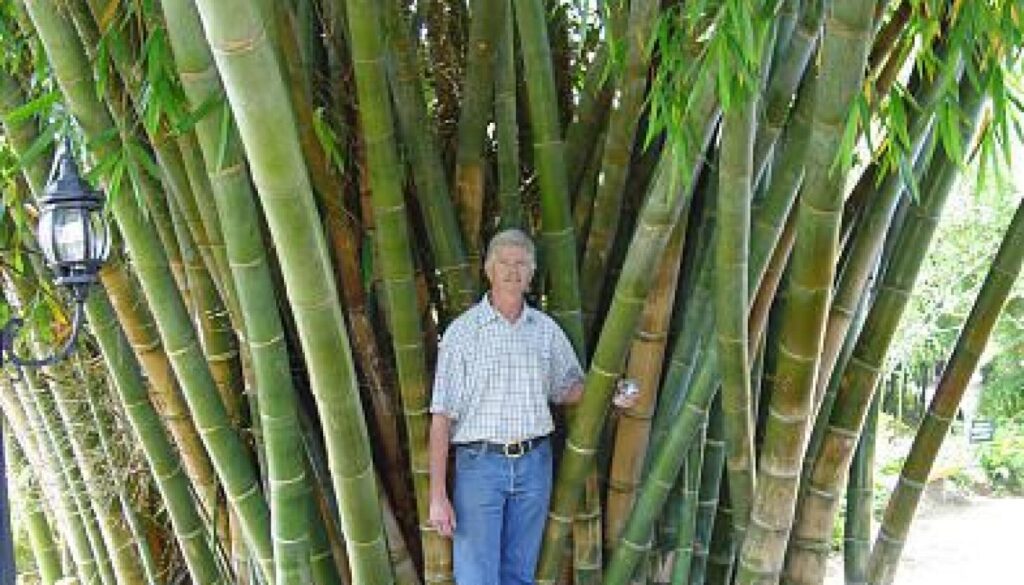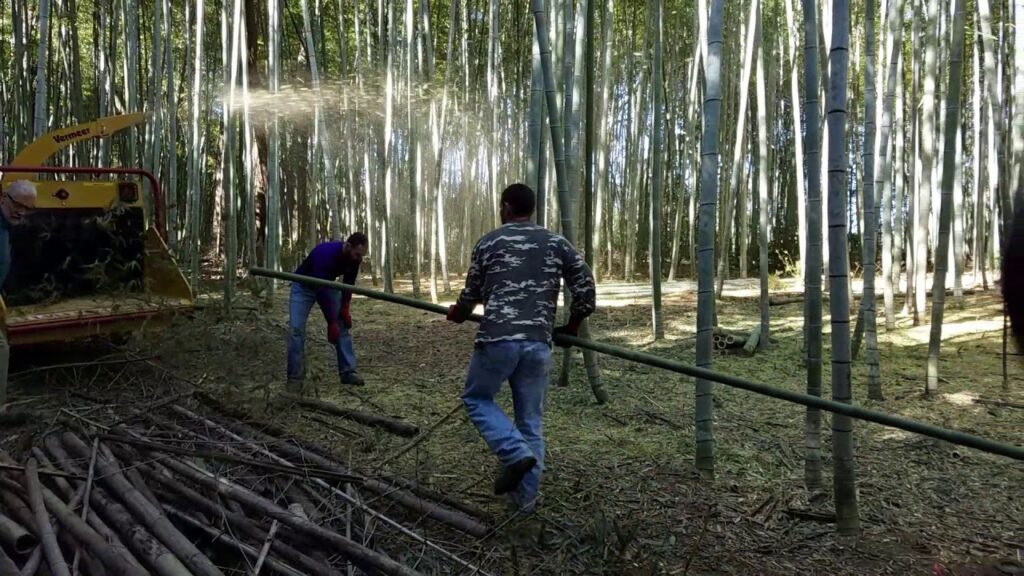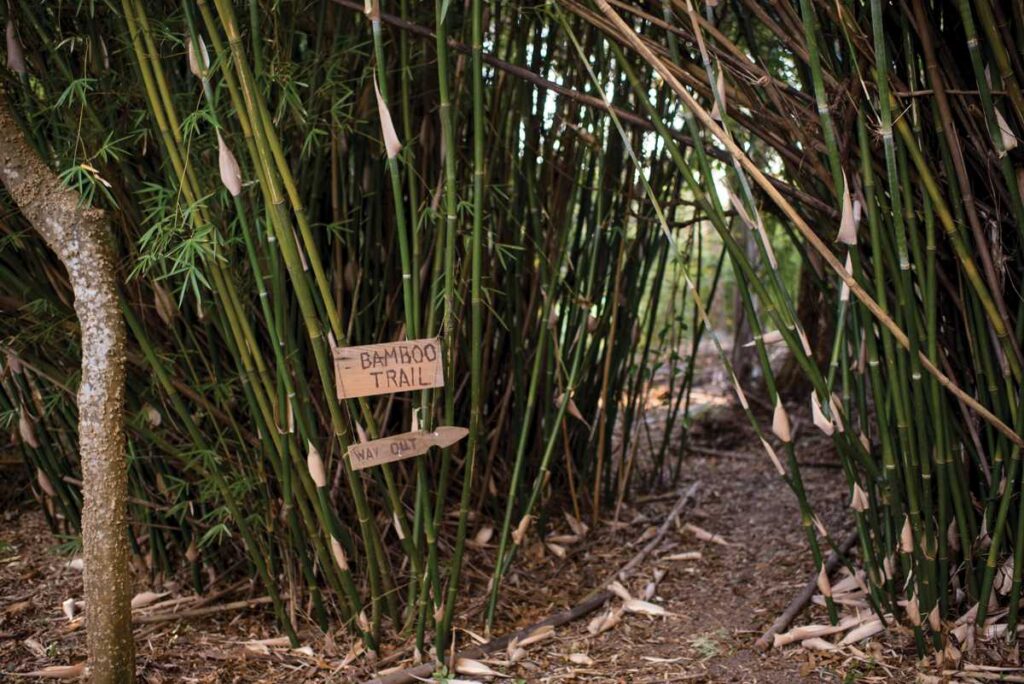American Bamboo Society, Blogging
American Bamboo Society

GENERAL BAMBOO QUESTIONS
Q. How do I find someone knowledgeable about bamboo to help me?
The American Bamboo Society has a help line. However, the best way to find information is to come to one of the Northern CA Chapter’s meetings and talk to experienced bamboo people. If you are not in Northern California an ABS Chapter nearer to you may be able to help. A list of ABS chapters is on this page of the ABS site, BAMBOO.ORG.
Q. What kind of bamboo should I plant?
If you are a beginner you probably should try to find a bamboo nursery somewhere near you. A local nursery would be familiar with your climate and soil conditions. If you can’t find one, then you can contact one of the suppliers close to you, who are willing to ship bamboo, and ask for advice. Be sure to tell them your hottest and coldest days, what your soil is like and how much rain you get. Do you want plants for decoration, a wind break, a privacy screen, to prevent soil erosion or forage for animals? How tall would you like it to be? Do you have lots of land that you’d like to fill with bamboo or do you have a small plot and want it well-contained? Deciding this beforehand will help a nursery suggest an appropriate variety.
Q. How can I find out what kind of bamboo I have?
Bamboo is notoriously difficult to identify more specifically than the species, unless there is something particularly remarkable about it. There are, by some estimates, as many as 2,000 kinds identified so far. Contacting a local chapter of the ABS and asking for help is probably the best idea. Be ready to answer a few questions. Is the plant entirely green? Are there any colors on the culms? Are the leaves variegated? What’s the average size of the leaves? How many branches typically come out of each node along the culm? How tall is it? How thick are the culms? Is it growing in clumps or are the culms spread out over a large area? Do the new shoots have a particular color? Sending along a close-up photo of any distinguishing parts of the bamboo might help.

Q. How do I let the world know about my wonderful bamboo product?
Well, if you are an ABS member, please send information about what you sell or the service you provide to the ABS Advertising Chair. Ads can appear in the bimonthly Magazine BAMBOO, the annual ABS Source List, or on the ABS web site. Also have a look at the current supplier source list to see the type of plants and products listed. If you are not a member, please consider joining the ABS and supporting our efforts.
CARE, GROWTH and PROPAGATION of BAMBOO
Q. How do I take care of my bamboo?
Taking care of bamboo is easy. If it seems to be doing well enough without care, anything you add will be an improvement. Any fertilizer (but not weed-n-feed types) that is sold for grass would be appropriate, though manure from any animal, compost or fish fertilizer would be just fine. Many bamboo people recommend organic, slow-release formulas. Bamboo needs quite a bit of water so if you have a long dry spell during the summer and the leaves curl, it’s past time to water.
Some bamboos do better in full sun, others in full shade. If you know what variety of bamboo you have, you can check the ABS Species Source List for the bamboos Sun/Shade index.
Don’t remove the leaves that drop from the plant, it serves as mulch around the base of the plant. The leaves contain silica that the plant will need for future growth and it keeps down weeds.
Bamboo culms (stalks) reach their maximum height in the first growing season and then, each year after that, usually add branches, until the culm is five to seven years old. Then it should be thinned out of the grove. Use a fine-toothed saw for large-diameter bamboo or sharp clippers for smaller-diameter culms.
If you notice light colored splotches on the tops of the leaves and silvery spots on the bottom of the leaves, you have bamboo mites. These don’t kill the bamboo, but they do make it look less beautiful. There are insecticidal soaps, home-brew remedies and biological controls that bamboo people try. If the discoloration doesn’t bother you, don’t do anything.
If you bought “Lucky Bamboo,” “Chinese Bamboo,” “Curly Bamboo” or “Water Bamboo” the plant you bought isn’t bamboo at all, and not even a grass. Or, if the plant you bought has been growing in a vase with just water and some rocks or marbles, it is a Dracaena (probably Dracaena sanderiana but also possibly D. deremensis or D. fragrans ‘Massangeana’, which is also called the corn plant.)
Q. How do I propagate bamboo?
Bamboo is usually propagated by digging up part of a clump of existing bamboo and moving it elsewhere (see the next question.) The vast majority of propagating is done that way and it results in most plants of most varieties in the U.S. being clones. If you divide a bamboo plant and put it in a new location, it usually doesn’t do much for the first few growing seasons. The first two years it puts out roots in its new location and usually by the third year it starts putting out larger culms. By the fourth or fifth years it’s putting out culms as large as that plant ever will in that location, with that much sun and that much water in that kind of soil.
Bamboo flowers only rarely, (sometimes there’s more than a person’s lifetime between flowerings) and when it does, it takes so much energy from the plant it often dies. People try various things to save them, like cutting back the culms and fertilizing generously, and sometimes that works.
It can also be propagated via germ plasm. A small number of cells are taken from some part of the plant and grown in glass dishes. Ordinary people don’t do this, of course.
Finally, with some tropical species, it’s possible to bend a culm in an existing clump of bamboo down to the ground, stake it and cover it partially with soil. Be sure to cover several of the nodes of the culm, as that’s where it will form roots. Don’t let the soil dry out completely.

Q. How do I transplant part of a large clump of bamboo?
Transplanting is hard work and involves digging a large chunk of root ball out of the ground. Never transplant bamboo when it is shooting. Dig bamboo either very early in the spring before there’s any chance of shooting or wait for the growth period to be over late in the autumn. You should look for a clump of culms that has come up in the last year or so and which includes at least three or four healthy-looking culms. A good size for the clump would be at least two feet in diameter. Bamboo roots (rhizomes) are tough but must not be allowed to dry out even for a few minutes. You may have to use a very sharp shovel, ax or saw to separate the roots from the rest of the grove. If you will be transferring the division by truck, then water the leaves and roots well, wrap the whole thing in plastic and get it into the ground as quickly as possible.
Q. I’ve heard that bamboo is the fastest-growing plant. Just how fast does it grow?
David Farrelly, in his The Book of Bamboo, says that bamboo has been measured to grow 47.6 inches in a 24-hour period. Other sources specify it was a Japanese scientist who measured the growth of a Phyllostachys bambusoides. That must have been under ideal conditions of heat, humidity and very fertile soil. But, in the less than perfect conditions in one local garden, new shoots of Phyllostachys nigra ‘Henon’ have grown about a foot a day. What’s most remarkable is that eight-inch diameter, 60 to 80 foot tall bamboos have reached that height in one growing season, which might have been as short as two months.
Q. Will bamboo grow where we have cold winters?
There are bamboos that will grow, though perhaps not thrive, where the winters sometimes reach -20° F. The ABS Species Source List gives guidance on cold tolerance. Here are interesting articles about growing bamboo in the Northeastern US and temperate bamboos.
Q. How do I get seeds to plant?
Bamboo flowers at irregular, and usually very lengthy, intervals. In some varieties the intervals can be longer than 50 years. Bamboo seeds are not readily available and there is no organized method for distributing them when a variety of bamboo does come into flower. You might ask at a bamboo specialty nursery if any bamboo has flowered recently and if they have seeds available. Here is the list of all bamboo nurseries known to the ABS.
Q. How do I care for my “Lucky Bamboo”?
The first thing to say is that small green stems in small vases filled with some rocks and a little water sold as Lucky Bamboo across the U. S. are not bamboo at all. They are not even a grass and none of the advice you might read on this site will pertain to Lucky Bamboo. The plant is actually a member of the Dracaena family, usually D. sanderana. It’s a common houseplant imported from Asia and you should be able to find care information where you purchased it or from the web site about Dracaena.
CONTROL of RUNNING BAMBOO
Q. My bamboo is growing where I don’t want it. What can I do?
The long answer, with more information, is here, thanks to Betty Shor of the Southern California Chapter of the ABS. If bamboo has been planted without a barrier and is now growing where you don’t want it, you have several choices. The choices all start out with digging a trench about 3 feet deep around the area where you want the bamboo to grow. You can then install rhizome barrier (available at bamboo nurseries), pour concrete at least three inches thick or fill the trench with loose gravel. If you choose the loose rock fill, you will have to use a sharp spade at the beginning of every growing season to cut down into the trench and sever any new rhizomes (underground stems) that try to cross the trench. If you choose barrier or concrete, you should leave an inch or two above ground level to make it easier to find the rhizomes that try to escape over the top of the barrier. Information on placing a barrier for bamboo can be found in the magazine BAMBOO, published by the American Bamboo Society: “Controlling Running Bamboo,” by Ian Connor and James Clever, Vol. 27, Issue 1, Feb. 2006, p. 10-11.
Eradicating Bamboo — Sometimes a local grower will be interested in digging bamboo out, especially if it is something a little unusual. You may be able to find a local grower by asking a nursery where they get theirs or from the ABS Species Source List, which has a section on bamboo suppliers across the country.

In removing running bamboo, the first concern is to separate what you want to eliminate from any portion that is to be retained; you must cut all underground stems. The root clumps of bamboos are very dense and woody. Some garden suppliers sell special tools for cutting through these clumps. According to Bamboo for Gardens, by Ted Jordan Meredith (Timber Press, 2001, p. 161-2): “The tool consists of a heavy metal rod with a sharp, heavy cutting blade welded to the bottom of the rod. A long, heavy, metal sleeve fits over the rod. The sleeve is lifted, and dropped or thrust downward, pounding the cutting edge through the cake of rhizomes. Reciprocating power saws and power digging tools are other options”.
Systemic herbicides can be used to kill bamboo, but this may require several repeated treatments. Author Ted Meredith says “cut the aboveground growth to the ground. Water and fertilize to encourage the rhizomes to generate new growth. As soon as the new shoots have leafed out, stop all watering, fertilize very heavily with a high-nitogen fertilizer, and spray with a strong [systemic] herbicide. Remove the culms and foliage once the herbicide has been fully absorbed. Remove all subsequent shoots before they leaf out.”
BAMBOO as a VISUAL or PRIVACY SCREEN
BAMBOO in CRAFTS
Q. How do I preserve bamboo culms for craft work?
The physical properties of bamboo make it a wonderful resource for craft work. However, the initial challenge for the craftsman is making sure the the culms will not be destroyed by beetles or fungal attacks or ruined by cracks and splits. A few basic rules may help for a successful harvest. Age, season of cutting, and post-cutting treatments are all crucial aspects. The culms should be mature (three to six years) and should be harvested in the dry season.
It is also recommended to harvest in the “young” season, when the new shoots are at their maximum height but have not leafed out yet. At this point mature culms are less susceptible to pests attack because they are rich in fiber rather then starch. Low moisture content also minimizes deterioration.
Once the culms are harvested they are best placed in a well-ventilated, covered, shaded area, avoiding direct wind or sun as a quick drying may cause splitting. Heating techniques are also used to “cure” the culms. In addition culms can be coated with tung oil. Nevertheless, it’s suggested that non-chemically treated culms are eventually destined to deteriorate because of biological attacks, especially if outdoors and exposed to rain. For this reason it is often recommended to treat culms with chemical mixes based on boric acid, borax, (Tim-Bor) and insecticides. Culms could be impregnated by submersion, or left standing in buckets filled with the curing product.
A very thorough review of bamboo preservation techniques is covered in the Bamboo Preservation Compendium by Dr. Walter Liese and Dr. Satish Kumar. The book describes the various pests and molds that afflict dried bamboo and the many treatments used in construction and crafts.
Q. How do I work with bamboo in crafts?
Nancy Bess, past ABS Arts & Crafts Chair, provided this answer. “I am a basket maker and use a little bamboo in my work; however, I have watched lots of Japanese craftspeople at work, so I’ll share what I have learned. Also, a book by Carol Stangler, The Craft and Art of Bamboo (Lark Books, ISBN: 1579901913), covers lots of the questions having to do with tools and procedures. I know she interviewed the Lingens, who are fence builders.
I use a paint stripping gun to bend bamboo. The pieces I use in the garden are about 3/4” wide and quite stiff. I pass the gun back and forth (it will scorch if you hold it in one place) over a four to five inch area — you can actually feel the cell structure break down — practice so you can control how much and how sharp the angle is. Where it cools down is where it stays. If you try bending after a long period of soaking, then where it dries is where it stays. Lots of craftspeople who make a product, make a jig (headless nails into plywood works) into which they can drop the hot (or wet) bamboo. This way they can produce identical pieces…if they want.
Many Japanese craftspeople use a heat source (boiling bath for some, gas oven for others, hibachi for many) to help remove the oil that is in bamboo. They roll the bamboo over (or in) the heat source and continually wipe the surface with a clean rag, much like stripping furniture. The bamboo must move continually or splotching occurs. Oil is removed to make the bamboo less inviting to insects, to harden it and stabilize the color. Air dry after – bamboo is a plant after all and loves to get mildew, etc.
Most craftspeople harvest bamboo when it is between two and five years old. The tissue is too soft before two years and it starts to deteriorate after five (some books say seven). Some craftspeople (especially for fences, work baskets, etc.) use bamboo green. For high quality products, the bamboo is aged. Dried in the sun, stored, oil removed, air dried.”
BAMBOO as FOOD
Q. Can I eat the shoots?
Bamboo shoots are usually cooked before eating as some may contain cyanogens. This is not a problem with most temperate bamboos, and most can be eaten without cooking if they are not too bitter. The only Phyllostachys known to have potentially toxic concentrations of cyanogens is Ph. heterocycla pubescens, also known as Ph. edulis and as Moso. Though it is the most important temperate bamboo for shoots, due to it’s early season, its size and the amount grown, it is usually somewhat bitter, and is always cooked before eating, Even though most bamboo growers often snack on some of the shoots while working with bamboo in the shooting season, eating a significant amount of raw shoots at one time might not be advisable unless one is sure of their safety. Properly prepared bamboo shoots are a safe, tasty and exotic addition to the table. The Washington State Extension Service has prepared a brochure about bamboo shoots with nutrition, preparation and storage information. Bamboo foliage is good fodder for some types of animals as well.
More to read: Cost of full body massage in Vietnam
Comments are closed.